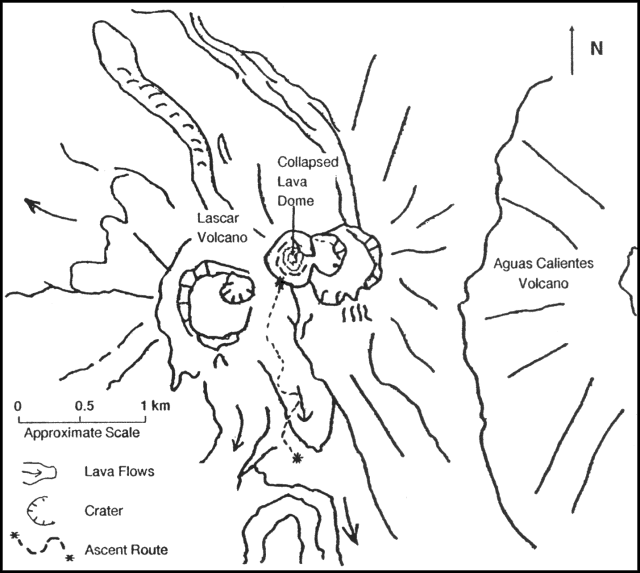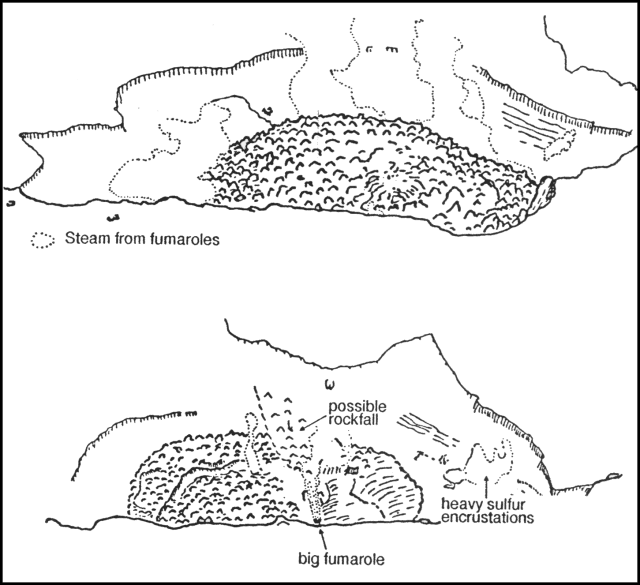Report on Lascar (Chile) — November 1989
Scientific Event Alert Network Bulletin, vol. 14, no. 11 (November 1989)
Managing Editor: Lindsay McClelland.
Lascar (Chile) Lava dome deflates; strong SO2 emission
Please cite this report as:
Global Volcanism Program, 1989. Report on Lascar (Chile) (McClelland, L., ed.). Scientific Event Alert Network Bulletin, 14:11. Smithsonian Institution. https://doi.org/10.5479/si.GVP.SEAN198911-355100
Lascar
Chile
23.37°S, 67.73°W; summit elev. 5592 m
All times are local (unless otherwise noted)
Lascar has been continuously active since the September 1986 explosive eruption. The lava dome that had been growing in the active crater in March and April 1989 had deflated by 19 October (figure 2) when an Argentine-Chilean geological team (José Viramonte, Carlos Peralta, Carlos Pérez, Luís Baeza, and Sergio Espinosa) climbed the volcano. Three ring faults were associated with the collapse, the outer with a 15-m scarp, the two others with scarps of only 0.5 and 1 m. Each was marked by a succession of fumaroles with intense steam-dominated emissions that had a strong HCl odor and had deposited sulfur sublimates. A recent phreatic crater 20 m in diameter cut the outer ring fault. Fumaroles on the ESE edge of the collapsed dome made a strong jet aircraft sound. Portable 2-component seismographs were installed at three sites on the cone 16-19 October. Only a few volcanic earthquakes accompanied significant regional-related earthquake activity, but significant tremor was recorded.
 |
Figure 2. Sketch map showing the collapsed lava dome in the W crater of the eastern of Lascar's two andesite cones, and the ascent route of the Argentine-Chilean team. Courtesy of J. Viramonte. |
Geologists from several institutions, including the Servicio Nacional de Geología y Minería, observed Lascar's activity from the ground and aircraft 21 October-17 November. The following is from their report.
"The dome, ~200 m in diameter, had deflated from the previously reported minimum volume of 1.5 x 106 m3 such that its top was at or below the crater floor (figure 3). We postulate that this may be due to magma withdrawal. We could find no evidence, either from local reports or from deposits near the crater, to suggest that any explosive activity has occurred since July 1988.
"Since April, regular observations of Lascar's plume, and the times of rumbling (retumbos), local earthquakes, and night glow above the crater have been compiled by Eduardo Necul Tello, a schoolteacher in Talabre, ~20 km WNW of Lascar. His observations document higher plumes, crater glow, and more frequent rumbling during April, which may correlate with the main period of dome extrusion. Rumbling reported by Necul on 10 October at noon may have been associated with dome collapse.
"The dome had one major fumarole on the SE edge of the crater. It was venting gas at extremely high velocities, creating a jet engine-like noise similar to that reported for pre-dome fumaroles (Danny Osborne, personal communication, 1984). As in April, most of the fumaroles were around the edge of the dome, but there were a few in the interior of the dome area that did not exist in April. The jet-like fumarole released by far the largest volume of gas. The dome was crossed by NW-SE cracks that may have been extensional during its growth." Bombs, probably from the September 1986 explosive activity, were collected for chemical analysis; they appeared dacitic in hand specimen.
"More than 70 COSPEC measurements of SO2 flux were obtained from several ground-based stations on the S and SE sides of Lascar 16-17 November. Preliminary data suggest that Lascar's SO2 output is in the range of 1,100-1,500 t/d. Based on daily observations of the plume during the last eight months, these two days of measured output are typical. Moreover, this level of gas release has been semi-continuous for the last four years.
"At any particular time, fewer than 10 volcanoes have SO2 emission rates that exceed 1,000 t/d. Such high rates generally indicate an open vent condition. If the 16-17 November rates at Lascar are extrapolated over longer periods, the extruded magma volume could not account for the amount of SO2 emitted, assuming an average dacite composition. We postulate that this reflects a distillation of SO2 from a subsurface magma body.
"Significant changes in Lascar's extrusive activity over the last few months and the apparent continued degassing of a magma body at depth indicate that this volcano should be routinely monitored. Over the short term, since April 1989, the explosive hazard potential of Lascar has decreased. However, the situation could change rapidly in the future."
Geological Summary. Láscar is the most active volcano of the northern Chilean Andes. The andesitic-to-dacitic stratovolcano contains six overlapping summit craters. Prominent lava flows descend its NW flanks. An older, higher stratovolcano 5 km E, Volcán Aguas Calientes, displays a well-developed summit crater and a probable Holocene lava flow near its summit (de Silva and Francis, 1991). Láscar consists of two major edifices; activity began at the eastern volcano and then shifted to the western cone. The largest eruption took place about 26,500 years ago, and following the eruption of the Tumbres scoria flow about 9000 years ago, activity shifted back to the eastern edifice, where three overlapping craters were formed. Frequent small-to-moderate explosive eruptions have been recorded since the mid-19th century, along with periodic larger eruptions that produced ashfall hundreds of kilometers away. The largest historical eruption took place in 1993, producing pyroclastic flows to 8.5 km NW of the summit and ashfall in Buenos Aires.
Information Contacts: M. Gardeweg, SERNAGEOMIN, Santiago; S. Foot, MINSAL Ltda., Santiago; R. Letelier, ONEMI, Santiago; L. Glaze, JPL; R. Andres and W. Rose, Michigan Technological Univ; P. Francis and S. de Silva, Lunar and Planetary Institute, Houston; S. Self, Univ of Texas; J. Viramonte, Univ Nacional de Salta, Argentina; S. Espinoza and L. Baeza, Univ del Norte, Antofagasta.


